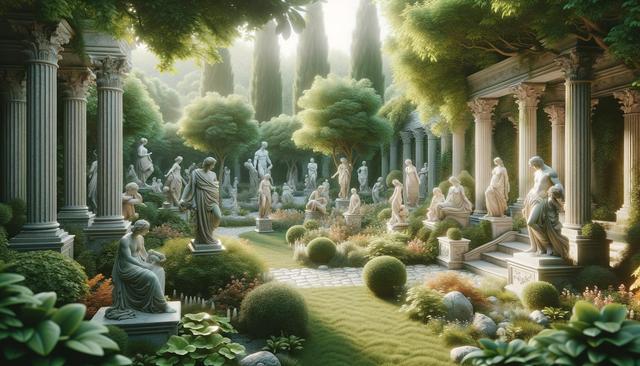The Artistic Impact of Garden Sculptures
Garden sculptures have long been used to add a sense of character and artistry to outdoor environments. Whether nestled among flower beds or standing as a focal point in an open lawn, sculptures provide visual interest and help define the mood of a garden. They can reflect personal taste, cultural influences, or even historical themes, making them more than just decorative objects. Choosing a sculpture that resonates with your landscape’s design can enhance the overall aesthetic and create a more immersive outdoor experience.
Art in the garden serves multiple functions beyond aesthetics. Strategically placed sculptures can direct the viewer’s gaze, draw attention to specific plants, or create a sense of mystery by inviting exploration. Materials used for garden sculptures—such as stone, metal, ceramic, or recycled elements—also contribute to the garden’s texture and atmosphere, offering a tactile contrast against the organic forms of plants and trees.
Types of Garden Sculptures to Consider
There is a wide variety of garden sculptures available, suitable for different styles and preferences. Some of the most popular types include:
- Abstract forms that emphasize shape and movement
- Figurative sculptures depicting people or animals
- Water features that incorporate sculptural elements
- Whimsical or fantasy-themed installations
- Minimalist and geometric designs for modern gardens
Each type of sculpture can serve a different purpose. For instance, a classical statue can evoke a sense of timelessness, while a modern steel piece might complement a contemporary landscape design. Gardeners often choose sculptures that reflect their own personalities or interests, making the space feel more personal and inviting.
Placement and Scale in Garden Design
Proper placement is key to integrating sculptures into a garden successfully. The size, shape, and location of a sculpture should complement the surrounding elements without overwhelming them. When considering placement, think about sight lines from various vantage points, including windows, pathways, and seating areas. A well-positioned sculpture can serve as a visual anchor or a subtle accent.
Scale is equally important. A small sculpture can get lost in a large garden, while an oversized piece might dominate a small courtyard. To achieve balance:
- Use smaller pieces in intimate garden corners
- Place medium-sized sculptures along pathways or near water features
- Reserve large, bold pieces for open spaces where they can be fully appreciated
Lighting also plays an essential role in sculpture presentation. Spotlights or subtle garden lighting can highlight textures and create dramatic effects during the evening hours, extending the sculpture’s impact beyond daylight.
Materials and Maintenance Considerations
The choice of materials affects both the appearance and the durability of garden sculptures. Common materials include:
- Stone – long-lasting and classic, ideal for traditional gardens
- Metal – creates modern or industrial appeal, though it may require treatment to prevent rust
- Ceramic – offers vibrant colors and intricate designs but may be fragile in cold climates
- Wood – blends naturally with greenery but needs regular maintenance to resist decay
Maintenance requirements vary significantly depending on the material. For instance, metal sculptures may need occasional cleaning and protective coatings, while stone pieces generally require less upkeep. It’s important to consider climate conditions in your area—extreme temperatures or high humidity can affect certain materials more than others. Regular inspection and cleaning will help preserve the sculpture’s appearance and structural integrity over time.
Incorporating Sculptures into Garden Themes
Garden sculptures can enhance specific themes or design concepts. For example, a Zen garden may feature minimalist stone pieces that evoke tranquility, while a wildlife-friendly garden might include animal sculptures that blend seamlessly with the natural habitat. Aligning your sculpture choices with your garden’s theme ensures a cohesive and harmonious look.
Here are a few ideas for thematic integration:
- Use antique-style busts or urns for a classical European garden
- Incorporate abstract shapes for a modern, architectural layout
- Choose rustic or reclaimed sculptures for a cottage or woodland garden
- Add playful or surreal figures in children’s or whimsical spaces
By thoughtfully selecting and placing sculptures, you can tell a story through your garden design, making the outdoor space not only beautiful but also meaningful. Sculptures offer a lasting way to express creativity and add depth to the garden’s narrative.
Conclusion: Personalizing Your Garden with Sculptural Art
Garden sculptures offer a creative way to personalize outdoor spaces, blending artistry with natural beauty. Their versatility in style, material, and function allows homeowners and garden enthusiasts to find pieces that reflect individual tastes and complement their landscape’s design. By considering factors such as placement, scale, and thematic alignment, sculptures can transform even the simplest gardens into expressive, dynamic environments. Whether you’re looking to create a peaceful retreat, an engaging visual journey, or a space filled with character, incorporating sculpture into your garden is a thoughtful and impactful choice.






